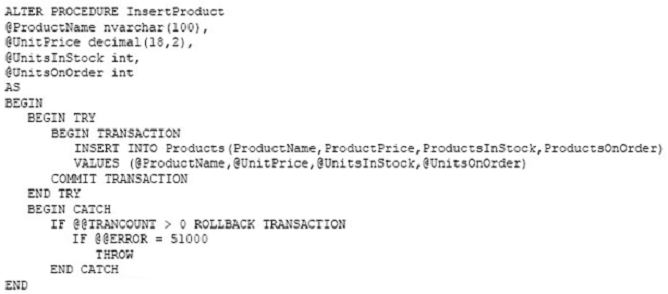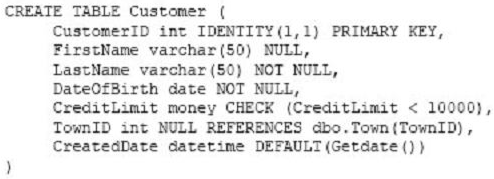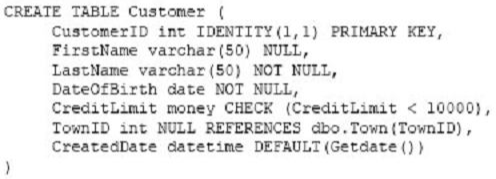File Info
| Exam | Querying Data with Transact-SQL |
| Number | 70-761 |
| File Name | Microsoft.70-761.PracticeTest.2019-04-14.114q.tqb |
| Size | 15 MB |
| Posted | Apr 14, 2019 |
| Download | Microsoft.70-761.PracticeTest.2019-04-14.114q.tqb |
How to open VCEX & EXAM Files?
Files with VCEX & EXAM extensions can be opened by ProfExam Simulator.
Coupon: MASTEREXAM
With discount: 20%





Demo Questions
Question 1



Note: This question is part of a series of questions that present the same scenario. Each question in the series contains a unique solution that might meet the stated goals. Some question sets might have more than one correct solution, while others might not have a correct solution.
After you answer a question in this section. You will NOT be able to return to it. As a result, these questions will not appear in the review screen.
You create a table named Products by running the following Transact-SQL statement:

You have the following stored procedure:

You need to modify the stored procedure to meet the following new requirements:
- Insert product records as a single unit of work.
- Return error number 51000 when a product fails to insert into the database.
- If a product record insert operation fails, the product information must not be permanently written to the database.
Solution: You run the following Transact-SQL statement:

Does the solution meet the goal?
- Yes
- No
Correct answer: B
Explanation:
A transaction is correctly defined for the INSERT INTO .VALUES statement, and if there is an error in the transaction it will be caught ant he transaction will be rolled back. However, error number 51000 will not be returned, as it is only used in an IF @ERROR = 51000 statement. Note: @@TRANCOUNT returns the number of BEGIN TRANSACTION statements that have occurred on the current connection.References:https://msdn.microsoft.com/en-us/library/ms187967.aspx A transaction is correctly defined for the INSERT INTO .VALUES statement, and if there is an error in the transaction it will be caught ant he transaction will be rolled back. However, error number 51000 will not be returned, as it is only used in an IF @ERROR = 51000 statement.
Note: @@TRANCOUNT returns the number of BEGIN TRANSACTION statements that have occurred on the current connection.
References:
https://msdn.microsoft.com/en-us/library/ms187967.aspx
Question 2



Note: This question is part of a series of questions that present the same scenario. Each question in the series contains a unique solution that might meet the stated goals. Some question sets might have more than one correct solution, while others might not have a correct solution.
After you answer a question in this section. You will NOT be able to return to it. As a result, these questions will not appear in the review screen.
You create a table named Customer by running the following Transact-SQL statement:

You must insert the following data into the Customer table:

You need to ensure that both records are inserted or neither record is inserted.
Solution: You run the following Transact-SQL statement:

Does the solution meet the goal?
- Yes
- No
Correct answer: B
Explanation:
As there are two separate INSERT INTO statements we cannot ensure that both or neither records are inserted. As there are two separate INSERT INTO statements we cannot ensure that both or neither records are inserted.
Question 3



Note: This question is part of a series of questions that present the same scenario. Each question in the series contains a unique solution that might meet the stated goals. Some question sets might have more than one correct solution, while others might not have a correct solution.
After you answer a question in this section. You will NOT be able to return to it. As a result, these questions will not appear in the review screen.
You create a table named Customer by running the following Transact-SQL statement:

You must insert the following data into the Customer table:

You need to ensure that both records are inserted or neither record is inserted.
Solution: You run the following Transact-SQL statement:

Does the solution meet the goal?
- Yes
- No
Correct answer: B
Explanation:
As there are two separate INSERT INTO statements we cannot ensure that both or neither records are inserted. As there are two separate INSERT INTO statements we cannot ensure that both or neither records are inserted.

